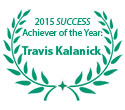Matt Salzberg grew up with a full dinner plate in middle-class Edison, N.J., a town named for the “Wizard of Menlo Park,” whose invention factory was just up the road. “My mother was a great cook,” says the CEO and co-founder of Blue Apron. “We ate out occasionally, but what I mainly remember is the wonderful home-cooked meals. And as a result, food became a major passion of mine.”
Entrepreneurship and a love of tasty made-in-the-kitchen food were instilled in Salzberg almost from birth—he told high school classmates he was going to launch companies. With a new Harvard University MBA in 2010, Salzberg took a job at Blackstone Group and later worked for Bessemer Venture Partners, but his startup demons were hopping. In Boston Salzberg met computer engineer Ilia Papas, and together they dreamed up a platform for research scientists called Petridish.
That idea never made it out of the lab, but the partners used the money they’d raised to follow an idea Papas had for packaging healthy meal ingredients in a box. “My partner and I wanted to create a brand that made cooking more accessible,” Salzberg says.
“My mother was a great cook…. And as a result, food became a major passion of mine.”
Blue Apron, whose partners include serious food guy Matt Wadiak (a disciple of famed chef Alice Waters), isn’t the first of its kind—that honor probably belongs to two Swedish startups, Middagsfrid (launched in 2007) and Linas Matkasse (2008). Both specialize in organic ingredients and support the farm-to-table movement, an aspect that carried over into the American versions (which include Plated, another company with Harvard Business School founders). Boston is the incubator for the meal-in-a-box movement—there is also Just Add Cooking and The Purple Carrot, an alternative vegan service.
Blue Apron (now based in New York) is definitely at the head of the table in the U.S., having tapped Salzberg’s business-school training to raise more than $190 million.
The fast-growing company, which reached a market-leading valuation of $2 billion in 2015, has 3,000 employees and ships 5 million meals per month from three big kitchens in the East, West and Midwest. The company’s monthly revenue has grown to $40 million.
Customers can choose meal plans for two or four people, with free delivery. What’s on the menu? We’re not talking burgers and fries. Instead customers can choose dishes such as crispy cod and spiced couscous with acorn squash and rainbow chard, or quinoa “fried rice” with baked tofu and choy sum.
The menus are interactive, Salzberg says, and home chefs can click on features telling them how to know when a pan is hot enough or how to zest a lemon. “We weave a lot of content into our meal prep that we think is great at helping people learn to cook,” he said. “The recipes are very thorough, and there are photographs of every step. If you need help, there’s also our customer service desk.”
The average prep time is 35 to 45 minutes, which works for busy schedules. That concept was also imported from Sweden. Niklas Aronsson, CEO of Linas Matkasse, told Forbes, “In Sweden, as in many other countries, both men and woman work full time, thus preparing a healthy dinner in the evening for the family becomes more and more a challenge.”
Some Blue Apron users say they’re learning to cook by following the company’s recipes. And the company wouldn’t be growing if the food wasn’t delicious. Salzberg says he clearly remembers the cardboard convenience foods of yore—like the frozen TV dinners Americans ate in the glow of The Ed Sullivan Show. We’re in a different era now, and freshness counts. “In our culture today, people care where their food comes from,” Salzberg says. “After World War II and the move to the suburbs, there was a big switch to fast food. And for that reason many people today didn’t learn cooking from their parents but want to gain that knowledge now, and that’s why our timing was right.”
It’s telling that fresh-food meal convenience is taking off at the same time that sales of low-cost frozen entrees are declining. Consumers clearly prefer quality and freshness over price. A few years ago, Mintel Global Market Research reported that the $40 billion frozen food market was seeing flat or declining sales across 98 percent of the segment. Euromonitor International reported that frozen meal sales dropped an alarming 3 percent from 2009 to 2013.
That’s not to say that Blue Apron is expensive for what the consumer gets. Meals cost about $10 per plate. That’s certainly cheaper than the restaurant alternative. And Salzberg says emphatically that buying the ingredients in his boxes one by one at a grocery store would cost at least 60 percent more. The company’s blog claims that, at a Whole Foods in Philadelphia, its shoppers paid $146 for the makings of Blue Apron’s three-meal package of chicken potstickers, center-cut pork chops and kumquat-glazed tilapia. Apron’s price was $59.94.
A MarketWatch test of Blue Apron’s claims produced more ambiguous results, with the ingredients of one meal costing more at Whole Foods, but two others were cheaper.
In fact, the company’s relatively low pricing probably contributes to the fact that Blue Apron isn’t making money yet, although Salzberg says “we’re making a good profit on every delivery meal. But we’re also investing quite a bit of money in marketing.” If Blue Apron becomes a household name, then there probably won’t be any further need to advertise its tempting fresh wares. Blue Apron? It’s what’s for dinner.
Read more 2015 SUCCESS Achievers of the Year stories:
This article appears in the February 2016 issue of SUCCESS magazine.







